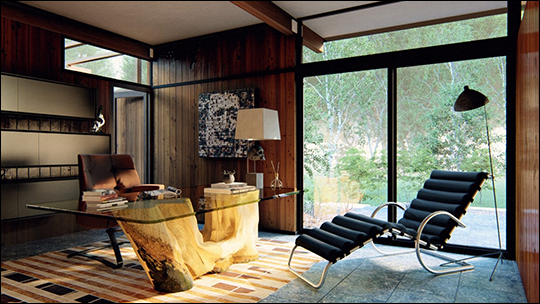
1. Textures
1.1: Color Map slot: This texture slot allows you to add your own Color Map (Diffuse/Albedo) texture to your model. A Color Map texture can include a so-called Alpha Channel which can be used for a variety of purposes. Please see section 6.5 below for more information.
You can also assign an .MP4 video file (maximum 50 MB per file) to the Color Map slot. This allows you to display animated textures for a variety of purposes, for example for a TV screen or a video wall. Click on the link below for more information:
Knowledge Base: How do you add a Video Texture to a TV?
Please note that textures with the padlock icon can't be copied or saved to a material file as they were assigned to the model outside Lumion.

1.2: Normal Map slot: This texture slot allows you to add your own Normal Map texture to your model.
Please see this article for more information:
知识库 : How do you use the Normal Map generator?
If your Normal Map contains an Alpha Channel, it will be used as a Gloss mask. This mask type supports 8 bits, i.e. all 256 greyscale tones in the Alpha Channel.

1.3: Create Normal Map: If you add a new Color Map texture to your material, Lumion will automatically create a Normal Map and a Gloss mask which adds depth and better definition to the material. You can click on this button to add a Normal Map manually:

Example of additional depth details from a Normal Map:

1.4: Flip Normal Map direction: After Lumion has created a Normal Map based on your Color Map, you can invert the depth direction by clicking on this button:

2. Standard sliders
2.1: Colorization: Between 0 and 0.5, the Color Map is tinted more and more by the color in the color selector. Between 0.5 and 1, the texture of the Color Map is progressively replaced by the selected color.

2.2: Brightness: To lighten/darken a surface, change the Brightness slider in the Color Selector:

2.3: Gloss: Change the Gloss slider value to sharpen or blur reflections.
If you use a Gloss mask in the Alpha Channel of the Normal Map (Click here for more information), slider values of 0.0 corresponds to no glossiness (very blurry reflections) and 1.0 corresponds to whatever the greyscale value of the Gloss mask is. Slider values above 1.0 will multiply the Gloss mask value by 1x to x2 (the result is capped at 2.0). If no Gloss mask is present, it assumes that the mask is 100% white (i.e. fully glossy at a slider value of 1.0-2.0).

2.4: Reflectivity: Reflection amount. Between 1.0 and 2.0, the material switches to metallic reflections which will tint the reflections with the material color.
If you use a Reflectivity mask in the Alpha Channel of the Normal Map (See section 6.5 below), slider values of 0.0 corresponds to no reflections and 1.0 corresponds to whatever the greyscale value of the Reflectivity mask is. Slider values above 1.0 will multiply the Reflectivity mask value by 1x to x2 (the result is capped at 2.0).

2.5: Relief: Material roughness - provided that the material uses a Normal Map.

2.6: Scale: Material size.
- If you set the Scale slider to 0, the material will use imported texture coordinates from your 3D modelling application (Imported Texture Placement).
- If you set the Scale slider to more than 0, the material will switch to box mapping with automatically applied texture coordinates (Box-mapping Texture Placement).

3. Expanded Settings: Position tab
3.1: X/Y/Z Offset: Adjust these sliders to change the position of the Color Map and Normal Map. This is only possible when the Scale slider value is above 0.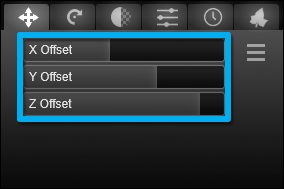
4. Expanded Settings: Orientation tab
4.1: Heading/Pitch/Bank: Adjust these sliders to change the orientation of the Color Map and Normal Map. This is only possible when the Scale slider value is above 0.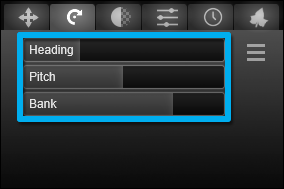
5. Expanded Settings: Transparency tab
5.1: Waxiness: Adjust this slider to change the waxiness of the material. The Waxiness function only works with sun light. Artificial light sources will not work. This is a known technical constraint. Just like in real life, bright materials will allow more light through than dark materials (that absorb the light), so black materials will not seem to have any effect, even when the Waxiness slider is set to the maximum amount.
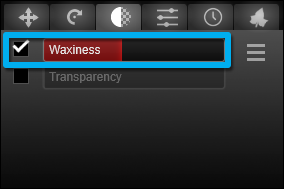
Example of Waxiness:

5.2: Transparency: Adjust this slider to change the transparency of the model.
If you use a Transparency mask in the Alpha Channel of the Color Map (See section 6.5 below), slider values of 0.0 corresponds to no transparency and 1.0 corresponds to whatever the transparency value of the Transparency mask is.
The final transparency value is converted to different levels of transparency based on the Output Quality setting that you render your images/movies with:
- 5-star Output Quality: 16 levels of transparency.
- 4-star Output Quality: 8 levels of transparency.
- 3-star Output Quality: 4 levels of transparency.
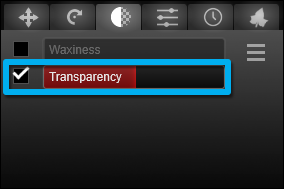
6. Expanded Settings: Settings tab
6.1: Emissive: A low value brightens the material and a high value makes it glow. If you add an Emissive mask to the Alpha Channel of the Color Map texture, the Emissive slider will only affect the masked areas (See section 6.5 below).
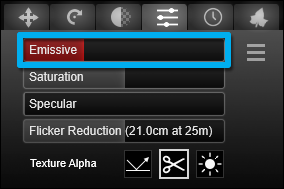
6.2: Saturation: A low value desaturates the Color Map texture and a high value makes it more saturated.
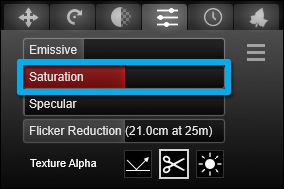
6.3: Specular: This slider allows you to boost specular highlights in the material.
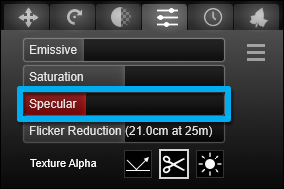
6.4: Flicker Reduction: You should only use this setting if overlapping surfaces flicker or disappear when you move the camera.
Avoid extreme Flicker Reduction values - you should only adjust it a little bit while holding down the Shift key and moving the mouse cursor left or right until the surface stops flickering.
The best method is to make sure that your surfaces are offset a bit in your 3D modelling application, so that the flickering is less likely to occur in the first place.
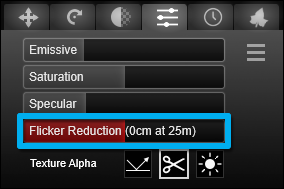
6.5: Texture Alpha: The three buttons let you specify whether the Alpha Channel in your Color Map is used as a Reflectivity mask, a Clip mask or as an Emissive mask.
By default, Lumion will set the second button - Color Map Alpha Clips Object - to on.

Please read the following articles to see how to use the Texture Alpha function and masks to make some parts of a material more or less reflective, transparent or emissive:
- 知识库 : How do you make some parts of a material more reflective?
- 知识库 : How do you make some parts of a material transparent?
- 知识库 : How do you make some parts of a material more emissive?
Example of Reflection mask:
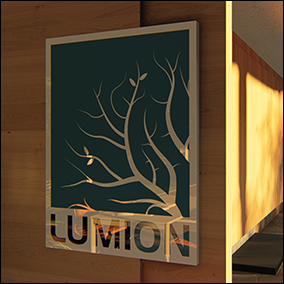
Example of Transparency mask:
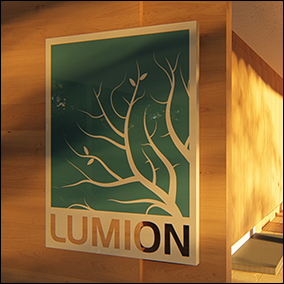
Example of Emissive mask:
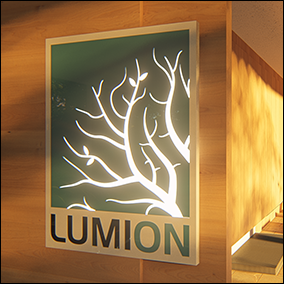
7. Expanded Settings: Weathering tab
7.1: Weathering: This slider adds ageing and weathering effects, dirt, worn edges, moss and rust to materials. The first step is to select a Weathering Preset that matches the material you are using. Then set the slider value.
- Presets (from top left to bottom right):
Stone, Wood, Leather
Brushed steel, Silver/Aluminium, Gold
Iron, Copper, Plastic - A value of 0 means that the material is brand new.
- A value of 0.0 to 0.5 makes it look increasingly old.
- A value of 0.5 to 1.0 makes it increasingly dirty in addition to looking old.
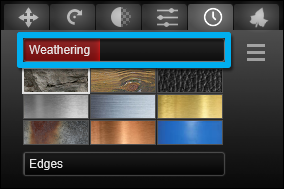
Example of Weathering:

7.2: Edges: This slider smooths the edges of objects.
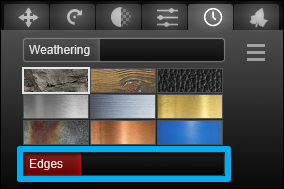
Example of Edges:
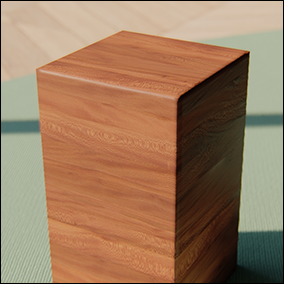
8. Expanded Settings: Foliage tab
8.1: Spread: Adjust this slider to change the distribution amount of the leaves.
If your Foliage leaves are distributed too thinly or unevenly on your surface, please read this article:
Knowledge Base: How do you prevent Foliage leaves from being too far apart on your model?
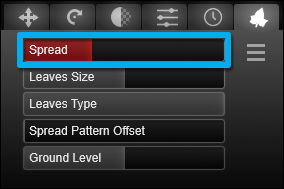
8.2: Leaves Size: Adjust this slider to change the size of the leaves.
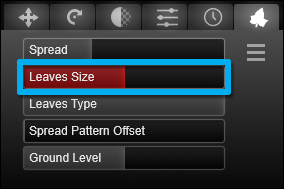
8.3: Leaves Type: Adjust this slider to change the leaf type. There are 9 presets.
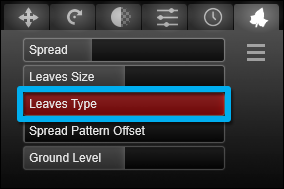
8.4: Spread Pattern Offset: Adjust this slider to randomize the distribution of the leaves on the model.
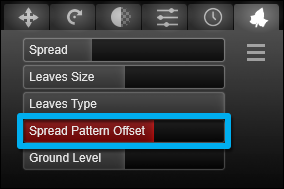
8.5: Ground Level: Adjust this slider if your model is above or below the Lumion Terrain. The slider value is in meters or feet depending in the chosen Units on the main Settings screen.
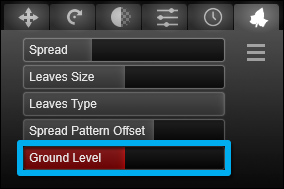
See also:
Knowledge Base: How do you copy, paste, save and load materials?